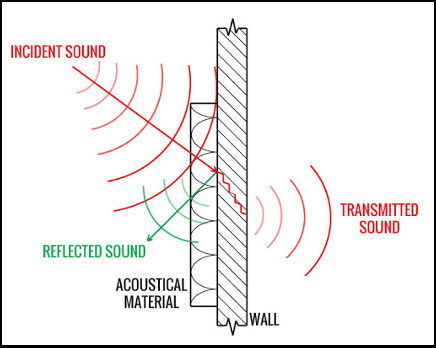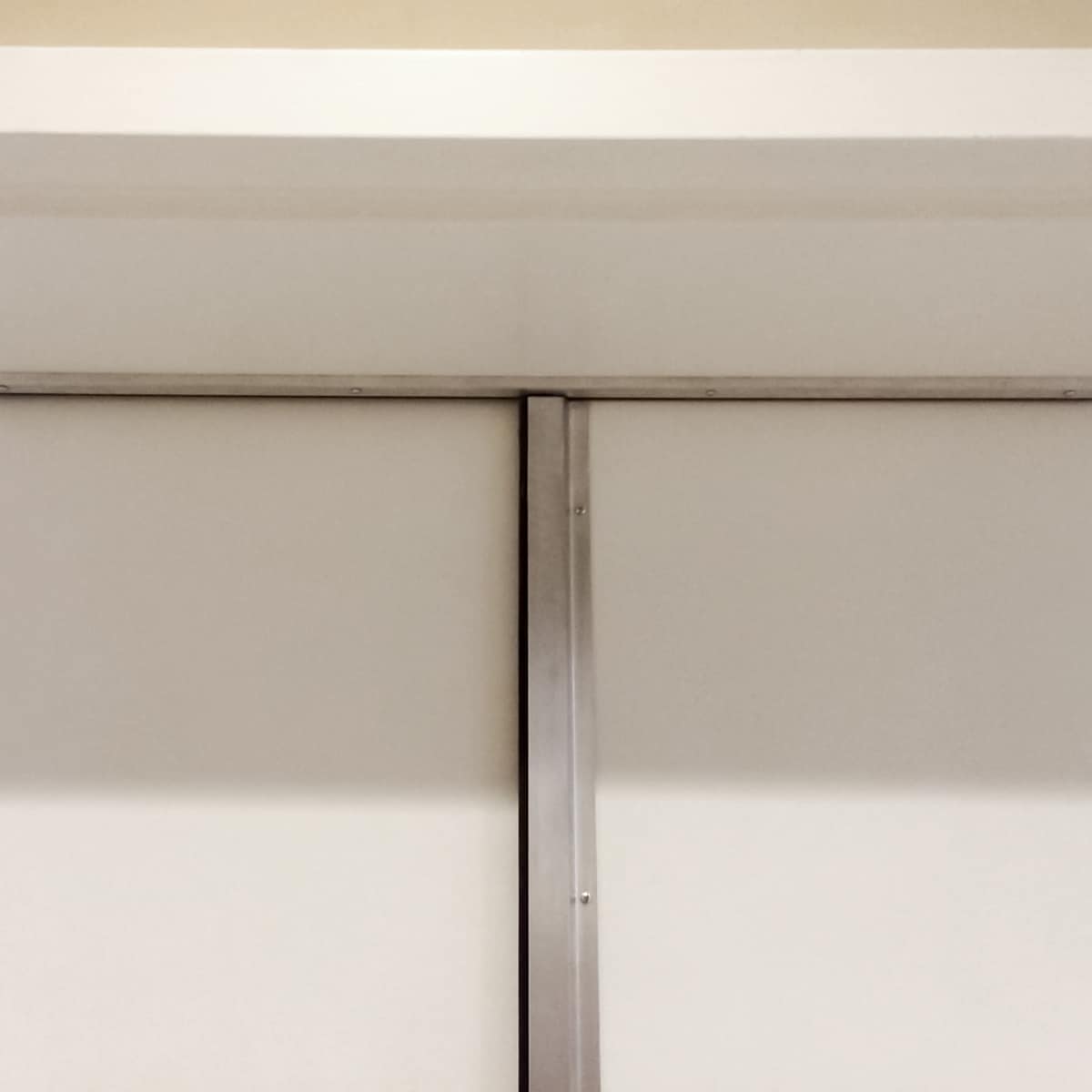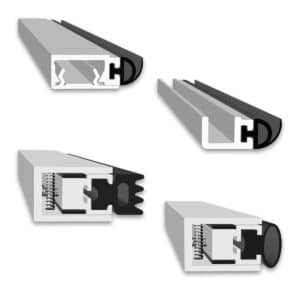Ever walked by one of your doors and wondered why you could hear so much noise coming from the other side? We understand the frustration. We get calls and emails all the time about how to block sound through walls, ceilings, floors, and windows.
It’s pretty surprising how often doors tend to get overlooked, and yet the reasons why are not that surprising—doors are literally the gateways we use to move in and out of spaces. Sound can move even easier through them, and that’s why they need to be properly sealed and perhaps even the door itself replaced, to achieve excellent soundproofing.
That’s why we created this article—to open the door to a world of possibilities in managing sound leaks, starting with your doorways.
Here’s everything you need to know about soundproofing a door.
Understanding Sound Transmission

Sound Absorption and Transmission
When we talk about soundproofing, we’re talking about how to block sounds with materials. The way sound works is that sound creates waves that vibrate through a medium—most commonly air—until they run out of energy and “go silent.”
For example, if you were standing at one end of a football field with me on the other end and you shouted, the sound waves produced by your vocal cords would vibrate across the field until they got to my ears. If you whispered, the sound waves would also vibrate toward me, but because they have so much less energy, they wouldn’t make it to my ears.
Materials and assemblies, like doors, windows, walls, ceilings, and floors are also mediums, and sound waves have no trouble vibrating their way through them either.
The point of soundproofing then is to utilize materials that can better absorb the energy in sound waves so that by the time they make it to the other side of the material, there is no energy left, and there is no sound.
Why You Should Soundproof Your Doors
Sound waves, from a physics perspective, are tricky and can get past even the smallest gap or opening, even within soundproofing materials. Considering that there are gaps around doors, even though theoretically they are sealed, there exists great potential for sound to make it through.
Think about it this way – you can add all the layers of mass-loaded vinyl and gypsum to your wall that you want, but if your door has even a 1% gap opening when closed, its sound-blocking capability is significantly reduced. Yes, you read that right – just a 1% gap opening can reduce door soundproofing effectiveness by 50%. That can be because of bad seals on the jambs, or maybe just one of the jambs. It also might be at the top of the door, or the seal at the bottom. The bottom seal is notorious for failing as it sees the most wear and tear over time.

Diagram of air flow and sound wave propagation through a small opening
That’s why it’s vital to consider soundproofing your doors. A soundproof door gives a room the right starting point to control the acoustics and create a high-quality sound environment.
How to Soundproof a Door: The First Steps to Take

Saint Peter’s Catholic Church – Here a set of double doors are acoustically sealed using 485 jamb seals, a surface mounted door automatic bottom and a 140 astragal for one active door. Shown here is the 140 astragal where it meets the 485 jamb seal.
Before we get to actual soundproofing products for your doors, it’s important to assess the situation and maybe make some adjustments or updates to prepare for them.
Sealing Gaps And Cracks
As noted, gaps and cracks are the main culprit for sound getting past doors. As we’ll see below, there are excellent products to stop this on the door itself, but we also need to look at the door frame, too. Start by inspecting your door frame and look for any cracks in the wood or failures in the caulking. If any are found, fill the cracks and recaulk the frame to achieve a sealed door frame.
Additionally, inspect the seal at the bottom and verify that the weatherstripping is still intact. Since the door is always brushing against the seal, feet sometimes step up on it, and the outside environment is constantly brushing up against it, weatherstripping fails faster than most things in a structure. Thankfully, they are easily replaced, and might solve some of the biggest gaps you have with your door.
Once the door frame and threshold have been taken care of, it’s not time to look at the door itself and apply any necessary soundproofing materials to guarantee a proper seal and solid sound barrier.
How To Soundproof A Door With Soundproofing Products
Depending on your situation, there are several effective methods and products we offer at Acoustical Solutions to properly soundproof your doors. Let’s examine 7 of my favorites:
Now that you know why it’s essential to soundproof your doors, you might be wondering how to accomplish it. Luckily, there are several effective methods and products available here at Acoustical Solutions that can help you soundproof your doors.
1. Door Seal Kits

Acoustic Door Seal Kit – 485-3 (not to scale)
Door seal kits are one of the most effective tools for soundproofing a door. The door must be sealed on all four sides for maximum effectiveness, which is why kits typically include automatic door bottoms, door jambs, and a threshold to engage the door bottom. I highly recommend our PrivacyShield® Soundproofing Door Seal Kit (Complete Set) for standard-sized doors.
See the difference here with a before and after:
It’s worth noting, however, that not all doors are ideal for sealing. For instance, pocket doors are notoriously difficult to seal effectively due to their design, which makes them a poor choice where sound transmission is a concern. Hollow-core doors aren’t as effective as blocking sound either. To that end, I often recommend replacing the door entirely (see below). If you have a solid door, then the door seal kit will be a gamechanger and perhaps all that you need.
If you’re in doubt about what’s best for your door, feel free to reach out or watch this video to see how acoustic door seal kits work and install.
2. Automatic Door Bottoms

Automatic Door Bottom 367 Surface Mount Aluminum Finish- 29/32″ deep x 1-29/32″ high
Unlike standard door sweeps you can buy from a building supply store, automatic door bottoms are a mechanically-activated solution that make soundproofing a door much easier.
These types of devices utilize a concealed flat spring mechanism that, when the door is closed, lowers a neoprene seal insert against the floor or saddle. The result is a tightly sealed door whenever closed, that will eliminate potential gaps or openings that could compromise soundproofing.
Automatic door bottoms come in various styles, including surface-mount, semi-mortised, and fully mortised. This variety lets you choose the design that best fits your specific needs and aesthetic preferences.
3. Door Jamb Seals

PrivacyShield® Soundproofing Door Seal Kit
PrivacyShield® Door Seal Kits (Top and Sides) are a fantastic solution for the sides and top of your door jamb. Our acoustical seals feature a unique compress-o-matic design, complete with a sound-absorbing neoprene rubber gasket that forms a tight seal when the door is closed.
These kits are available in versions that attach to existing door jambs or door frames, which makes it a versatile application to suit various door types and structures.
4. Door Astragals for Double Doors

Acoustic Double Door Astragal – Style 328 Aluminum
Soundproofing double doors requires a slightly different approach. Our Acoustic Double Door Astragals are specially designed to seal off the air gaps that usually occur where double doors meet, to effectively prevent sound leaks and enhance the overall soundproofing.
5. Door Thresholds and Saddles

Acoustic Door Threshold
Acoustical door thresholds, also known as saddles, are designed with a neoprene bulb with a protruding rubber finger. This innovative design helps correct any misalignment in the door as it’s closed to further improve the soundproofing effectiveness.
When used with an automatic door bottom, the door has a solid surface to seal onto, which provides a superior seal. Depending on the specific flooring situation, a threshold might be critical to achieving optimal soundproofing results.
6. Cam Lift Door Hinges

Cam Lift Hinge
Cam lift door hinges are another excellent solution for soundproofing your doors. Their lifting action enhances the sealing characteristics along the door perimeter by lifting and lowering the door with the swing. This action ensures a secure seal each time the door is closed, which makes these hinges an excellent addition to any soundproofing project.
7. Replacing Your Door

PrivacyShield® Soundproof Door
In some cases, the most effective way to soundproof your space may be to replace your existing door entirely. Consider opting for something like our PrivacyShield® Soundproof Door. It comes with everything you need to make your space as soundproof as possible.
Our PrivacyShield Soundproof Door is one of the most affordable options on the market, but the cost is still out of reach for many. If your budget doesn’t allow for the cost of soundproof door, you might also consider a two door system with an air gap, solid core doors, and door seal kits. I’ve used this on both home and professional studios with great success.

Overly Quick Ship Metal Acoustical Door
Additionally, we have a metal soundproof door, the Overly Metal Acoustical Door. We offer this as a quick ship option when looking for metal over wood, a great product that offers excellent soundproofing qualities!
Maintenance And Long-Term Care
Buildings are living creatures that move over time, even if only in small ways.
Considering how they are tied together, these small movements are what causes cracks to form, which can allow sound to enter and escape again. Once your door is soundproofed, it’s ideal to set a schedule or remind yourself to check the door at regular intervals to make sure that no seals fail or cracks form. Check both the frame for cracks and gaps, having caulk handy for any patch work, and also check the soundproofing products to make sure they are still properly installed and aligned as originally intended.
Soundproof Your Doors Today with Acoustical Solutions
There’s no denying the impact that soundproofing a door can have on the comfort, privacy, and functionality of your space. By taking steps to address potential sound leaks in your doors, you can significantly improve your acoustic environment.
Don’t wait to experience the benefits of a soundproofed space.
Contact us today to explore our wide range of products and start your journey towards a quieter, more peaceful environment!
To learn more about how Acoustical Solutions can solve your noise control problems, use our contact form, call one of our Acoustical Sales Consultants at (800) 782-5742, or visit us on the web at acousticalsolutions.com.
Hello Ivan,
Thank you visiting AcousticalSolutions.com! I received the comment you submitted on my blog post and wanted to respond to you directly.
The main difference you are going to find between weather-stripping vs. the acoustical seals we carry are that our materials are actually tested to block sound. For instance, the model # 485 & 475 jamb seals are tested to achieve up to an STC 47 in door assemblies meeting this criteria and the model # 170 & 770 jamb seals are tested to achieve up to an STC 55 in door assemblies meeting that criteria.
Contact Ryan Colton
Who would I hire to install door seals and door covers. Also approximately how much would this cost for a standard apartment door? Thanks linda
Hello Linda,
Thank you visiting AcousticalSolutions.com!
In most circumstances you would hire a general contractor or if your apartment building has a maintenance person, they would be the one to install this type of material for you. If you rent your apartment you will want to check with your landlord that it is okay to make modifications. Even though doors seals can be removed, installation still requires that holes are drilled into the door jamb and door. Pricing for door seal kits is provided on the product page.
Where can I buy one of these kits and do you ship to Canada?
Thank you for contacting Acoustical Solutions. At this time, our web store is not setup for orders shipping into Canada. An order may be placed by phone or over email. There are a few different models to chose from, with the most popular being the 485-2. Please note that these kits are sized for a standard, 3’0″ x 7’0″ door size. Be sure to accurately measure the door opening prior to ordering. If your door is not a 3’0″ x 7’0″ door size, we can customize a door seal kit solution for you. It would be tailored to your specific needs and have a slightly longer lead time. If you would like a quote on the kit or a custom option, please provide me with your requirements and shipping details. Please let us know if you have any other questions or would like to discuss this further.
Do your door seal kits, door bottoms, etc meet code if installed on fire doors in my Ontario home.
Hello Michael, thank you for contacting Acoustical Solutions. Whether or not our door seals would meet fire code is going to be dependent on the particular code in your locality which varies from state to state, and in your case may be very different since you are in Canada and not the United States where we are based. My recommendation would be to contact your local fire marshal and show them the materials you are considering to purchase to see if they tell you if they meet your local code or not.